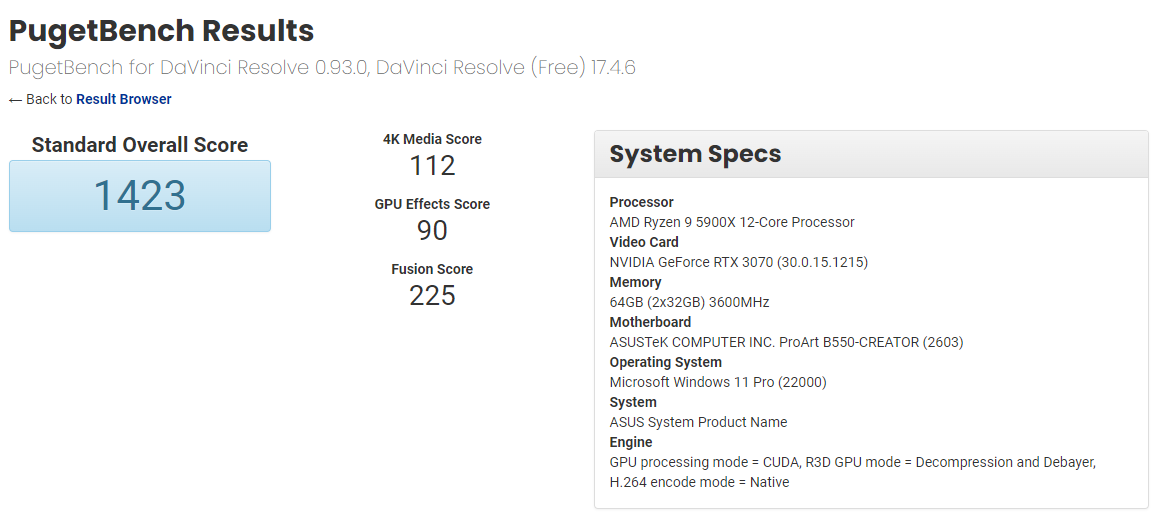Upcoming Intel Arc A770 Desktop GPU Tested With Unreleased Drivers
Intel's upcoming Arc A770 discrete GPU has been benchmarked on Puget Bench's DaVinci Resolve routine on legacy hardware - with drivers still unavailable to the public.
Intel's upcoming performance-tier Arc Alchemist A770 discrete desktop GPU is inching closer and closer to release. A recent Puget Bench score result for DaVinci Resolve has been uploaded to the benchmarking platform, and there appears to be some secret sauce behind the results themselves: the utility reports a graphics driver version that's actually more recent than the one currently available for early adopters of Intel's Arc A350M and A370M mobile graphics solutions.
The benchmarks themselves offer little information on Intel's upcoming A770 GPU, since the results aren't really comparable to those achieved by other GPUs. While Intel's own estimates place the Arc A770's performance somewhere between the RTX 3060 and RTX 3070, the actual performance in the GPU Effects benchmark - 45 in the first and 39 in the second - stands at roughly half the score of RTX 3070 solutions (90) in the same database. Take these benchmarks with a pinch of salt until official details are revealed. Intel's Arc A770 is expected to launch with two VRAM capacities (8 GB and 16 GB GDDR6), which feeds the cards' 32 Xe cores and 4,092 FP32 cores over a 256-bit bus.



Part of the reason for that performance discrepancy may stand with the drivers themselves. Intel has been doubling down on its driver development ever since it announced development of its own discrete, high-performance GPU architecture. Interestingly, the tested Arc A770 makes use of the yet-unavailable 30.0.101.1723 driver version - apparently much more recent than the generally-available, Arc-30.0.101.1330 which still powers the mostly South Korea-exclusive Intel Arc-powered laptops. The driver version also surpasses the one being used by Intel's integrated graphics drivers, which are currently on version .1660.
The usage of this latest driver branch may include support for desktop versions of Arc hardware, or it simply might include a number of fixed, outstanding issues with the current Arc Alchemist driver implementation. The hardware used in the benchmarks also builds the case of an internal Intel test: the Arc A770 was tested with a Coffee Lake engineering motherboard, alongside Intel's Core i5-9600K CPU. Using older, time-tested components for a new desktop graphics card does sound like a way for Intel to focus on existing Arc A770 issues, ruling out the sometimes lingering problems in new platforms that could throw a wrench on GPU diagnostics.
Intel's driver work is likely accelerating as we inch closer to the actual release of its desktop-bound discrete GPUs. The increasing number of appearances in graphics benchmark software suggests that might happen sooner rather than later. Whether any of Intel's GPUs will feature in our Best GPU Picks, of course, is another matter altogether.
Get Tom's Hardware's best news and in-depth reviews, straight to your inbox.

Francisco Pires is a freelance news writer for Tom's Hardware with a soft side for quantum computing.
-
jp7189 The market could really use a third competitor right now, but if Intel's flagship is half as fast as a 3070 with the power draw of a 3090, they might as well not release it.Reply -
-Fran- I'm starting to wonder if Intel is not trying too hard now to not lose the "hype" and momentum for their cards as it feels (strong implication of "no hard evidence to back this up") as if their shine was lost the minute they fumbled the Q1 time frame and started giving excuses for their release; just like they did with 10nm with the "but it's out there in Laptops you can't easily and readily buy, but they exist!".Reply
Regards. -
TerryLaze Intel also loves to segment their stuff so a gaming GPU not doing so well in Davinci might not be saying anything about their gaming capabilities.Reply
At the end pricing will be the determining factor here, if it is priced according to its capabilities in gaming compared to other gaming cards it will do fine. -
cfbcfb Replyjp7189 said:The market could really use a third competitor right now, but if Intel's flagship is half as fast as a 3070 with the power draw of a 3090, they might as well not release it.
Hmm. Where did you find the unreleased power demands of the A770?
Because its around 120 watts, and a 3090 is around 450.
Not even close.
The A770 should be less than a 3060 in terms of wattage. -
escksu Replyjp7189 said:The market could really use a third competitor right now, but if Intel's flagship is half as fast as a 3070 with the power draw of a 3090, they might as well not release it.
Looking at the mobile version, we are pretty such it won't draw as much power as 3090, nowhere near it.The A370M will consume around 50-60W of power. While the desktop variant should be faster and draw more power, its not going to draw 8-9x more power.
The 3D rendered photo also shows a normal 2 slot cooler which is clear insufficient if it uses as much power as 3090.